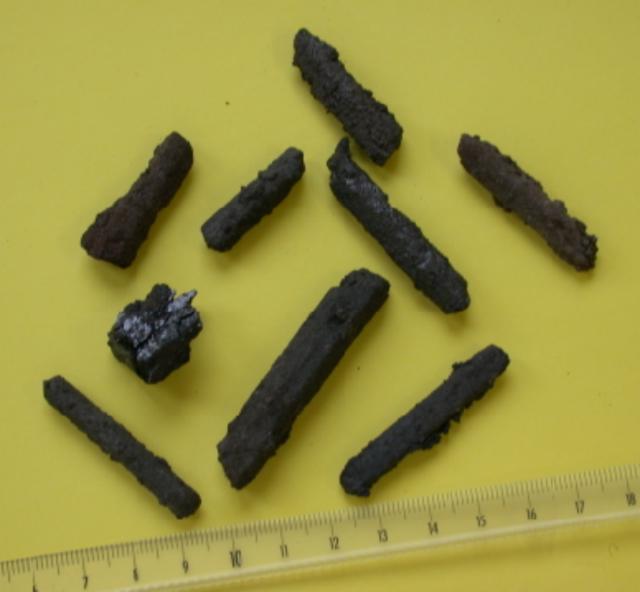Report on Etna (Italy) — October 2001
Bulletin of the Global Volcanism Network, vol. 26, no. 10 (October 2001)
Managing Editor: Richard Wunderman.
Etna (Italy) Amphibole megacrysts from the 2001 S-flank eruption
Please cite this report as:
Global Volcanism Program, 2001. Report on Etna (Italy) (Wunderman, R., ed.). Bulletin of the Global Volcanism Network, 26:10. Smithsonian Institution. https://doi.org/10.5479/si.GVP.BGVN200110-211060
Etna
Italy
37.748°N, 14.999°E; summit elev. 3357 m
All times are local (unless otherwise noted)
On 18 July a new vent opened on the S flank at 2,100 m elevation (BGVN 26:09). Lava from that vent contained exceptionally large crystals of amphibole (Pargasite-kaersutite) reaching to 6-8 cm along the c axis and less than 1 cm along the b axis (figure 91). These megacrysts, apparently blown loose by Strombolian explosions, were weakly adhering to the scoriaceous part of the flow, most of them found as isolated crystals practically free of lava. More rarely, amphibole is not elongated and may be confused with pyroxene.
 |
Figure 91. Photograph of amphibole megacrysts found in the lavas emitted during the July 2001 S-flank eruption at Etna. Courtesy of Roberto Clocchiatti. |
Acicular amphibole crystals 2 or 3 cm long were also common. In thin section, their central part contains spherical voids, which seems to indicate that the mineral grew in contact with gas bubbles. Gas present in fluid inclusions probably consists of water vapor at low density. The crystals often occur in areas with elevated silica. We presume that these areas resulted from siliceous inclusions, perhaps from sandstones, which clearly occur as inclusions elsewhere in the host lava. Other minerals included within amphibole consist of plagioclase (An85-76), olivine (Fo75), pyroxene (Wo45-En42-Fs13), Fe-Ti oxides, and numerous iron and copper sulfides. These sulfides do not resemble those from immiscible sulfur liquids within silicate melts, but are aggregates or trapped within fluid inclusions, and their compositions, mostly pyrite or copper pyrite, suggest an origin from magma cooling in a shallow reservoir.
The amphibole megacrysts are practically unzoned. They sometimes show a thin reaction rim of rhonite and fassaite within a melt strongly enriched in Si, Al, and alkalis. Microprobe analyses show that their composition is roughly that of a kaersutite close to pargasite or ferropargasite (table 8). Although kaersutite is occasionally found in ancient Etnean products, it has never been observed as phenocrysts in lavas during the past 2,000 years, let alone as such large crystals. The 2001 host lava is a K-trachybasalt whose chemical composition is practically identical to that of the lava with elevated K, Rb, and Cs content that first appeared in 1974 and started a period of stronger activity, probably linked to selective assimilation of rocks from the sedimentary and metamorphic basement (Tanguy and Kieffer, 1976, Clocchiatti and others, 1988).
Table 8. Amphibole microprobe analysis for megacrysts of the July 2001 S-flank eruption at Etna. Number of analyses was 60; oxide total was 98.79 wt. %. Courtesy of Roberto Clocchiatti.
| Amphibole | SiO2 | TiO2 | Al2O3 | FeO | MgO | CaO | Na2O | K2O |
| Oxide Percentage | 39.59 | 3.76 | 14.07 | 11.15 | 13.50 | 12.17 | 2.36 | 1.09 |
| Std Deviation | 0.36 | 0.29 | 0.29 | 0.31 | 0.20 | 0.16 | 0.07 | 0.08 |
In the present case, the amphibole megacrysts are closely linked to the early products of the 2,100 m vent, which also display numerous white sandstone inclusions sometimes reaching the size of a human head. Amphibole as well as sandstone inclusions are less frequent in the products from the 2,600-m vent and are not found in lavas from the upper vents (2,700-3,000 m elevation). Although investigations are still in progress, it may be hypothesized that the amphibole developed under high water pressure at a later stage of crystallization, probably near the sandstone roof of a small, shallow magma chamber. The recent origin of the amphibole megacrysts is also testified by their K-content, which reflects the higher K contents of magmas from the past 30 years (figure 92).
 |
Figure 92. A plot of K2O versus Na2O for various amphiboles found at Etna. Courtesy of Jean-Claude Tanguy and Roberto Clocchiatti. |
References. Tanguy, J.C., and Kieffer, G., 1976, The 1974 eruption at Mount Etna: Bulletin of Volcanology, v. 40, no. 4, p. 239-253.
Clocchiatti, R., Joron, J.L., and Treuil, M., 1988, The role of selective alkali contamination in the evolution of recent historic lavas of Mt. Etna: Journal of Volcanological and Geothermal Research, v. 34, p. 241-249.
Geological Summary. Mount Etna, towering above Catania on the island of Sicily, has one of the world's longest documented records of volcanism, dating back to 1500 BCE. Historical lava flows of basaltic composition cover much of the surface of this massive volcano, whose edifice is the highest and most voluminous in Italy. The Mongibello stratovolcano, truncated by several small calderas, was constructed during the late Pleistocene and Holocene over an older shield volcano. The most prominent morphological feature of Etna is the Valle del Bove, a 5 x 10 km caldera open to the east. Two styles of eruptive activity typically occur, sometimes simultaneously. Persistent explosive eruptions, sometimes with minor lava emissions, take place from one or more summit craters. Flank vents, typically with higher effusion rates, are less frequently active and originate from fissures that open progressively downward from near the summit (usually accompanied by Strombolian eruptions at the upper end). Cinder cones are commonly constructed over the vents of lower-flank lava flows. Lava flows extend to the foot of the volcano on all sides and have reached the sea over a broad area on the SE flank.
Information Contacts: Roberto Clocchiatti, CNRS and CEN Saclay,91191 Gif s/ Yvette cedex, France; Jean-Claude Tanguy, University of Paris 6 and IPGP, 94107 St. Maur des Fossés cedex, France.

